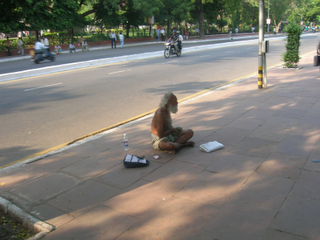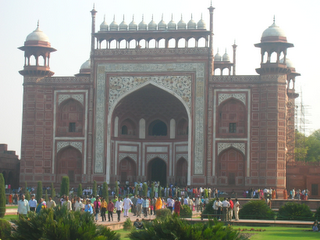 Having access to broadband is simply wonderful! Throughout the trip I noticed the impact that dialup and old software have on the new AJAX applications. This blog software for example fails to work for picture uploads on dialups. This could either be the connection speed or the old software that is in use. There is a considerable amount of PC's in India that still use windows 98, are ridden of viruses. You use a pendrive for example in some cybercafé along the road that is owned by the shopkeeper and you walk out with a pendrive with a couple of applications more on the disk. Insert it into your work computer and you're infected.
Having access to broadband is simply wonderful! Throughout the trip I noticed the impact that dialup and old software have on the new AJAX applications. This blog software for example fails to work for picture uploads on dialups. This could either be the connection speed or the old software that is in use. There is a considerable amount of PC's in India that still use windows 98, are ridden of viruses. You use a pendrive for example in some cybercafé along the road that is owned by the shopkeeper and you walk out with a pendrive with a couple of applications more on the disk. Insert it into your work computer and you're infected.Well, this picture above was taken in Delhi, one of those that I took very quickly during the trip. It's a priest in the streets. The end count of pictures is 967 and they fit perfectly on a 700MB CD. I like to have taken pictures of the very common things inbetween the monumental pics, because they show outsiders very well what the region of the country that we visited is like. Notice the use of the word "REGION", because travelling 200km already takes you to a place that is noticeable different in motor-taxi's, clothes, food and population.
 Here on the left is the portal to the Taj Mahal. You can notice the architecture that is abundant across India, the towers with round dome and in this case Mogul type archways.
Here on the left is the portal to the Taj Mahal. You can notice the architecture that is abundant across India, the towers with round dome and in this case Mogul type archways.Looking closer near the main archway, you see a rectangular white/black line. This is actually a poem in Arabic. The photo was taken from the middle of the garden inbetween the gate and the Taj.
Contrary to regular expectation, I'm not going to write "final comments" in this blog about India. It simply is unfit to capture a whole country as such with that much diversity into a single statement and since I have only started to touch the surface, it would not be justified. Also, as a software engineer, I did not visit Bangalore which is a must if I was to make any comments about the industry.
I can however write a couple of observations from the trip which are interesting
to ponder for Indians and foreigners:
- The Indians are highly entrepreneurial. This entrepreneurial activity ranges from agriculture up/down to regular commerce, up to powerful investors and hotel chain owners and new innovative startups (like US tax handling in India, medical photo handling, etc)
- There is a high demand boom for management people in the country, not just because of domestic interest but quite highly for providing links for export/import.
- There are many research centres in India and other initiatives that aim at a particular thing to be resolved. Jaipur for example has a medical center where they treat only 2-3 illnesses, but the process for doing that has been so thought out and improved that they can handle hundreds if not thousands of cases per year.
- I got the impression that identification of risk for Indians may be difficult.
- Indians leave large ambiguous gaps in communication with others, especially when foreigners do not understand the particular balancing of the head that has a specific meaning. Not sure if this persists in software as well, but if so, I can understand this to create problems in requirements engineering.
- I perceive the country at the moment as service-based and also the people as highly service-oriented, not so much production or manufacturing based. This means for example you will find very nice hotels, people willing to help you everywhere and earn a buck, but maybe not so many companies that are exceptionally strong in producing a product. However this is more based on intuition than academic or empirical research.
The interesting part at the start of the book already is that he makes the point that there is no reason to get really concerned about world economic activity, where countries like China and India are gaining foothold in the world markets, but other countries are not.
One of the common assumptions that he challenges is that people see the increase of one country's economy as a threat or a necessary decrease in the economy of another. As if the world's resources and economy are fixed (but may be growing slightly) and these are to be divided between the countries determined by their efficiency and capability.
His assertion is that there is no such thing, only "growth" and that this growth brings along new opportunities altogether. Now, this is an interesting statement! Consider for example the market for i-pods. At the moment the market for this apparel is about 1 billion people over the world? But there are about 6 billion at the moment. That means that if the poor that at the moment cannot yet afford an iPod will never buy one (maybe steal it and the original owner buy a new one). However, if 2 billion more people get into this market, the market for iPods multiplies three-fold!
The other very important thing to consider here is a country's production and waste. Pollution, packaging and these types will go up significantly, as is the number of cars that will drive around. Will the world be up to that level of pollution produced? That is a difficult question.




No comments:
Post a Comment